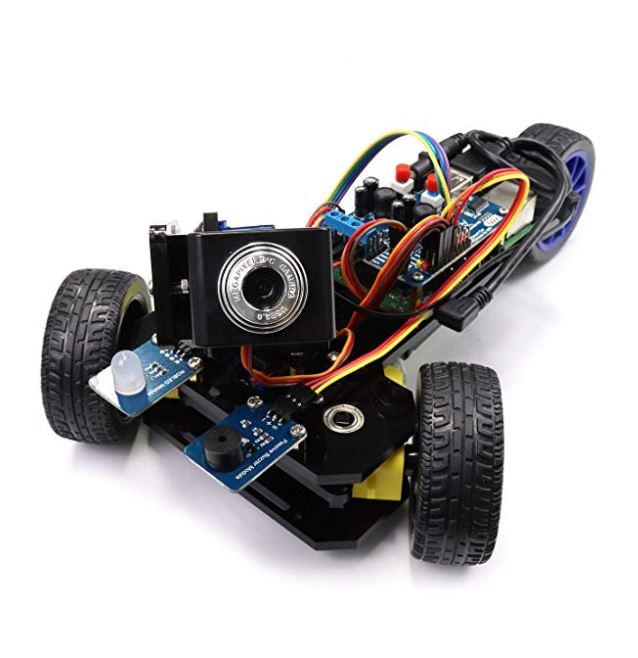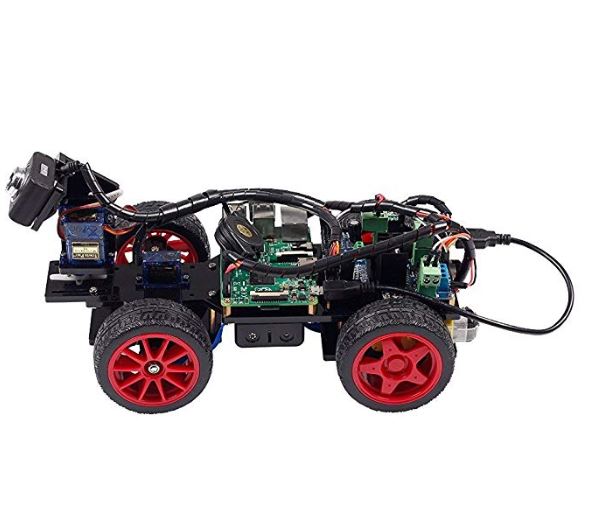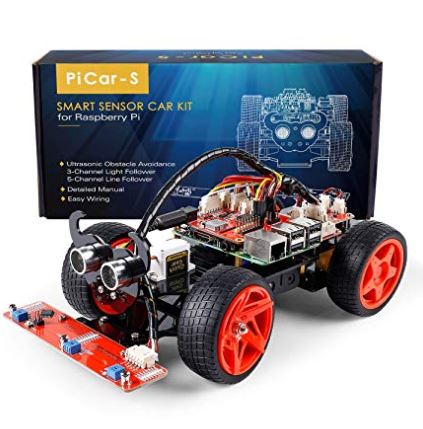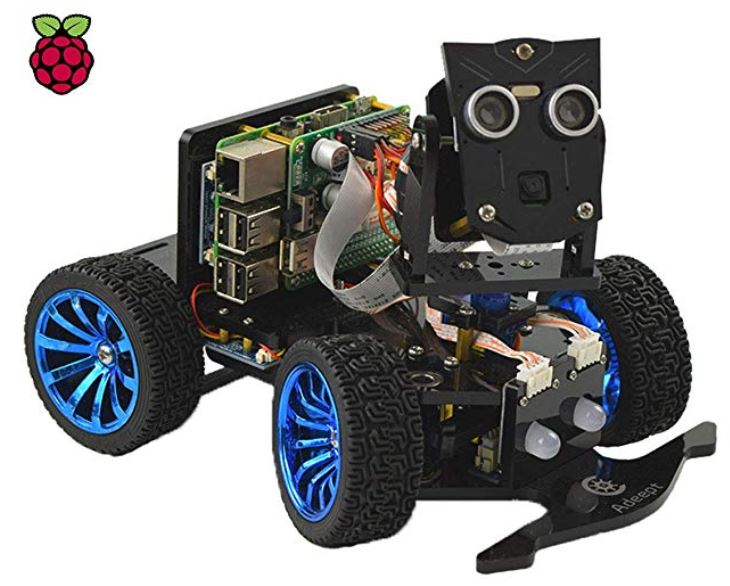Robotics Kits
The easiest way to get started with robotics is to get hold of a kit and follow the instructions on the supplier’s website. There are a few kits out there, but here are a few available kits, not in any particular order that you might wish to consider:
- Freenove Three-Wheeled Smart Car Kit (approximately $60)
Rating:




- No Pi (works with 4 B 3 B+ B A+)
- Easy setup
- Adjustable camera
This car has two working modes. (Assembly required. Raspberry Pi and Battery are NOT included.) Provides detailed assembly tutorial and complete code (Python) -> The download link can be found on the product box. (No paper tutorial.) Compatible models -> Raspberry Pi 4B / 3B+ / 3B / 3A+. (2B / B+ is also compatible but needs extra parts.) (Raspberry Pi is NOT included in this kit.) Control methods -> Controlled wirelessly by your Android phone or tablet, iPhone and computer (run Windows or Raspberry Pi OS). Needs battery -> Refer to “About_Battery.pdf” in downloaded file to buy.

- SunFounder Raspberry Pi Smart Video Robot Car Kit (approximately $109)
- Rating:




- No Pi (works with 4B 3B+ 3B 2B)
- Easy setup
- Remote control on PC
- Rating:
An AI self-driving raspberry PiCar-X is an integration solution for learning robotics programming, robotics knowledge and electronics assembling. PiCar-X robot car kit has an easy-to-assemble aluminum alloy body, so users can start driving within minutes of assembly. PiCar-X includes a pan-tilt camera, an ultrasonic module, and a line-tracking module, and is capable of avoiding obstacles, following objects, tracking lines, and recognizing objects.). PiCar-X robot car kit supports both Python and Blockly (like Scratch). It is easy to complete projects even without programming knowledge. PiCar-X offers professional and high-quality online

- SunFounder Raspberry Pi Car DIY Robot Ki PiCar-S (approximately $95)
- Rating:




- Good chassis, sensors
- No Pi (works with 4B/3B/3B+/2B/2B+)
- Rating:
The Pi Car-S is a cool smart car that works with Raspberry Pi model B+, 2 model B and 3 model B+ 3 model B. With three sensor modules including ultrasonic obstacle avoidance, light follower, and line follower, you can easily control the car and complete many different tasks. The robot is designed with construction plates in a solid, durable, and shatterproof structure. Includes high performance 9g servo motors. Python code is provided for the car, and you can also program and debug it with Dragit, a Snap-based graphical interface, by just simple dragging and dropping the code blocks for more complex functions.

- Xiaor Geek DS Robot Car (approximately $200)
- Rating:




- Comes with Raspberry Pi 3B+
- HD webcam
- Remote control by app
- Easy to program
- Rating:
This car is quick and easy to build. It can be controlled via its iPhone/Android app. The kit features an HD camera with 2-axis pan-and-tilt servos that enable the car to take photos or videos at many different angles. The code for the car is written in python and is open source, so you can change it however you want. The kit comes with a 2200mAh battery pack with charger, to provide continuous power and longer endurance. The kit also comes with the complete source code and video tutorials.

- Adeept Mars Rover PiCar-B Robot Car Kitit (approximately $74)
- Rating:




- Pi is NOT included (works with 4 3B B+ 2B,=)
- Powered by 2×18650 batteries (NOT included)
- Rating:
This robot contains many ‘artificial intelligence’ capabilities, such as speech recognition, ultrasonic obstacle avoidance, infrared reflection line tracking, and real-time video transmission. The robot is easy to assemble and code, and comes with strong technical support.

- GoPiGo3 Robot – Advanced Classroom Kit (approximately $375)
- Rating:





- Contains Pi, sensors, motors, power supply
- Great controller, really good chassis
- Rating:
Top of Form
Bottom of Form
The Cadillac of Raspberry P car kits Raspberry Pi robot car is perfect for learning coding. Adapt to use at all levels, whether it’s introducing robotics to the classroom or for graduate level students looking for a mobile platform for conducting robotics research Motors have built-in encoders, giving the robot precise and accurate motor control and ensuring it drives straight every time Connect 5 sensors (2 analog/digital, 2 I2C, and 1 serial), 2 servos, and a camera. Program the 2 onboard LEDs in the front, as well as 2 multicolored LEDs on the top. Robot broadcasts a Wi-Fi® signal that connects directly to your device. Access the DexterOS software through a web browser – nothing to download or install. Thick acrylic, strong metal, and a better assembly experience protect robot against bumps and falls. Soft rubber wheels give robot precise movement and better traction on all surfaces. Dozens of built-in lessons make it easy to get started learning how to program the robot. Lessons also cover the sensors, how to use them, and the basics of programming. Built-in lessons are in Bloxter, a drag-and-drop language similar to Scratch (and based on Blockly, a language by Google). Bloxter makes it fun and simple to learn how to program, while also offering advanced features for those that want to go beyond the basics. A clean, simple Python programming area with easily accessible sample programs and a variety of pre-installed libraries is also available. Kid contains everything you need for a classroom setting or for multiple sponsored competition teams.

Pi Wars UCSD Challenges

Rules will be updated if clarification is required. Please be sure tw=o read the notes at the bottom of this page. The rules are intended to give an overview of the challenge courses only – actual scoring systems may change and further details may be added.
The disaster-themed challenges for the 2023 competition are as follows.
Autonomous-only
Autonomous challenges are where the Raspberry Pi is controlling the robot by itself for the duration of the challenge without interference from the operator.
Autonomous or Remote Control
These challenges can be tacked either autonomously or by remote control. More points are generally available for those tackling the challenges autonomously.
Remote Control
Remote-controlled challenges are where one (or more) members of the team are controlling the robot via wireless controller(s). The challenges can be tackled autonomously for no extra points (i.e. just for the fun of it!)
Challenge Points
- There will be a number of different challenges into which you may enter your robot, the results of which will contribute to an overall score.
- Points structures will be published by Pi Wars to ensure that teams are aware of how many points each challenge is potentially worth.
- None of the challenges are mandatory.
- No points will be earned from challenges not entered.
- There may be some physical requirements for specific challenges – please review the individual challenges for more information.
Opportunities for more points / prizes
There are additional opportunities to gain more points which increase your overall score. These are:
- Blogging– in which your pre-event exploits are described in words, videos are shot and photographs are taken. For complete details on creating the blog, please follow this link.
- Technical Merit – in which robot features, build quality and other technical aspects are scored by an expert judge on the day of the competition.
- Artistic Merit – in which the design of the robot and other aesthetic aspects are scored by an expert judge on the day of the competition.
- Most Disastrous Robot – in keeping with our theme for this year, the Special Award for the competition goes to the robot that has the design most influenced by disasters. This can be natural, man-made or movie-style disasters, or even a combination of all of these types! It also includes “responses to disaster” such as rescue vehicles and the like.
Notes
- The rules may be changed slightly or clarified following comments and questions from competitors.
- The points systems for each challenge may change, probably in favour of the autonomous challenges.
Ask Questions and Discuss
You can discuss the challenges and ask questions on the discussion forum or send questions to piwarsucsd@gmail.com.

